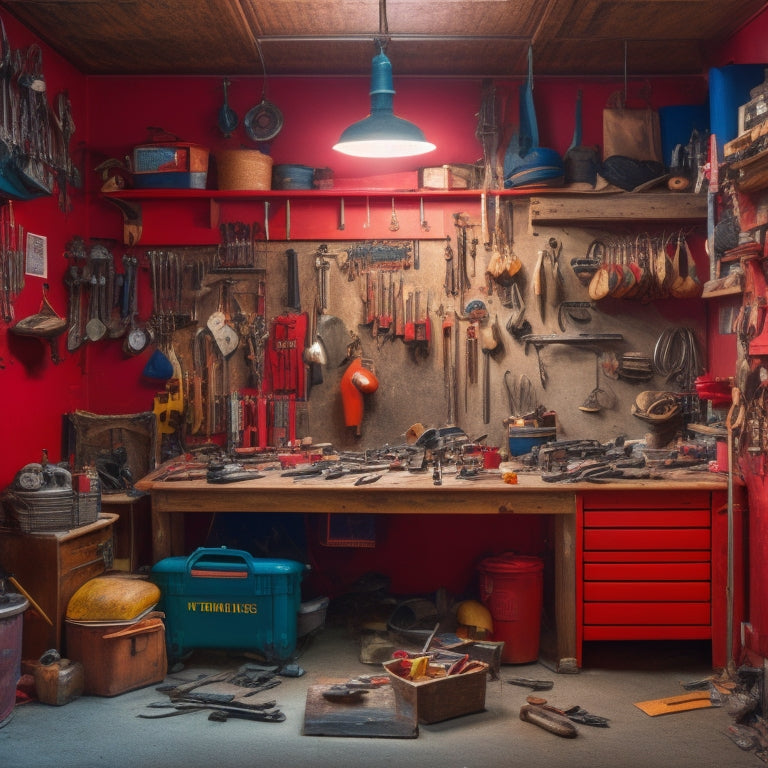
What's Holding Back Your Tool Storage System?
Share
You're likely wasting time and money due to a tool storage system plagued by clutter, inefficiencies, and security risks. Limited space and clutter might be forcing you to work around obstacles, while inefficient tool retrieval methods are costing you valuable time. Disorganized key management systems and inadequate security measures only add to the problem. And if you're still using outdated tool storage solutions, it's no wonder your workflow is suffering. Take a step back and assess your system - chances are, one or more of these five common flaws are holding you back from peak productivity and efficiency.
Key Takeaways
• Limited space and clutter hinder tool accessibility and efficiency, emphasizing the need for creative storage solutions and decluttering strategies.
• Inefficient tool retrieval methods, such as poor labeling and illogical layouts, waste time and frustrate workers, requiring a reorganization of tools and workstations.
• Disorganized key management systems lead to lost productivity and wasted time, necessitating designated key stations and organized storage solutions.
• Inadequate security measures put tools and equipment at risk of theft or damage, highlighting the importance of access controls, surveillance, and alarms.
• Outdated tool storage solutions, marked by obsolete equipment and inefficient layouts, must be upgraded to modern, efficient systems that boost productivity and save time.
Limited Space and Clutter
When you're working with power tools and equipment, you're often faced with the frustrating reality of limited space and clutter that can slow down your workflow and increase the risk of accidents.
To combat this, exploring vertical storage options that maximize your available space becomes crucial. Consider installing shelving units, hooks, or pegboards to keep frequently used tools within easy reach. Implementing creative organization techniques, such as categorizing tools by type or frequency of use, can also help streamline your workflow.
In addition to vertical storage, employing space-saving hacks can make a significant difference. Look for opportunities to repurpose existing storage containers or invest in compact, multi-functional toolboxes. Decluttering strategies, like regularly cleaning out your toolbox or designating a 'junk drawer' for infrequently used items, can also help reduce clutter and improve efficiency.
Inefficient Tool Retrieval Methods
Retrieving tools from a cluttered workspace can be a frustrating and time-consuming process, especially if you're forced to dig through a disorganized toolbox or scour the workbench for a specific item. You're not alone if you've wasted precious minutes searching for a tool that's hidden from view or misplaced.
Inefficient tool retrieval methods can significantly impact your productivity and workflow. One common issue is improper tool labeling. When tools aren't properly labeled, it's easy to misplace them or confuse similar-looking tools. This can lead to delays and mistakes on the job.
Another problem is inefficient tool layout. If your tools are scattered across the workbench or stored in a random order, it's difficult to find what you need quickly. To improve your tool retrieval methods, start by implementing a clear labeling system and organizing your tools in a logical order.
Consider categorizing tools by type or frequency of use, and store them in designated areas. By streamlining your tool retrieval process, you'll save time, reduce frustration, and enhance your overall efficiency.
Disorganized Key Management Systems
You're likely familiar with the hassle of searching for a specific key amidst a jumbled mess of keys, hooks, and clips, wasting valuable time that could be better spent on the task at hand. A disorganized key management system can be frustrating and inefficient. To overcome this, implementing effective key organization and management strategies is crucial.
Here are four key takeaways to get you started:
-
Designate a key station: Assign a specific area for key storage, making it easy to find and access the keys you need.
-
Utilize a key organizer: Invest in a key organizer or a pegboard with labeled hooks to keep keys tidy and organized.
-
Establish a checkout system: Set up a system where users can check out keys, ensuring accountability and reducing loss or misplacement.
- Conduct regular key audits: Schedule regular audits to identify and address any key management issues, preventing them from becoming major problems.
Inadequate Security Measures
Insufficient security measures put your tools and equipment at risk of theft or damage, jeopardizing your entire operation and bottom line. You can't afford to overlook the security of your tool storage system. Leaving your tools vulnerable to unauthorized access can result in significant financial losses and disrupt your workflow.
Additionally, security vulnerabilities can also jeopardize the safety of your employees and customers.
To prevent these risks, you need to evaluate your current security measures and identify potential weaknesses. Consider implementing robust access controls, such as biometric authentication or smart locks, to make certain that only authorized personnel can access your tools.
Furthermore, invest in surveillance systems and alarms to deter potential thieves and detect any suspicious activity. By addressing these security vulnerabilities, you can protect your valuable assets and maintain a secure working environment.
Don't let insufficient security measures hinder your tool storage system – take proactive steps to safeguard your tools and equipment today.
Outdated Tool Storage Solutions
As you've secured your tools and equipment from potential threats, it's time to assess whether your current tool storage solutions are hindering your productivity and efficiency. Are you still using traditional setups that are no longer serving you? Take a closer look at your storage system and identify areas that need improvement.
Here are some signs that your tool storage solutions are outdated:
-
Obsolete equipment: Are you still using old, worn-out storage units that are no longer functional?
-
Limited accessibility: Do you have to dig through cluttered shelves or rummage through disorganized bins to find what you need?
-
Inefficient use of space: Are you wasting valuable space with inefficient storage layouts or bulky containers?
- Inadequate organization: Are your tools and equipment not properly categorized, making it difficult to find what you need when you need it?
It's time to upgrade your tool storage solutions to modern, efficient systems that save you time and increase your productivity. By identifying and addressing these areas, you can create a more streamlined and organized workspace that serves you and your team better.
Frequently Asked Questions
Can a Tool Storage System Be Customized for Unique Tool Shapes and Sizes?
Imagine effortlessly storing peculiarly shaped tools in custom-fit compartments. Yes, you can customize your tool storage system with tool-specific compartments, ensuring a snug fit for each unique tool, making your workspace a model of efficiency.
How Can I Ensure Tool Storage Systems Comply With Industry Regulations?
You verify tool storage systems comply with industry regulations by referencing compliance standards, such as OSHA or AS9100, and following regulatory guidelines to guarantee adherence to specific industry requirements.
Are Tool Storage Systems Suitable for Outdoor or Harsh Environments?
You're expecting your tool storage systems to withstand a million rainy days, right? Fortunately, you can find systems designed for outdoor or harsh environments, boasting weather resistance, durability, corrosion protection, and impact resistance to keep your tools safe and ready.
Can Tool Storage Systems Be Integrated With Existing Workflows and Software?
You'll face integration challenges when connecting tool storage systems to existing workflows and software, but look for systems with open APIs and software compatibility checks to guarantee seamless integration and minimize disruptions.
What Maintenance Is Required to Extend the Lifespan of Tool Storage Systems?
'Just like a well-oiled machine, you'll keep your tool storage system running smoothly by performing regular cleaning and proper lubrication, ensuring peak performance and extending its lifespan, so you can focus on serving others efficiently.'
Related Posts
-

Maximum Capacity Tool Boxes for Heavy-Duty Use
You need a maximum capacity tool box that can withstand the rigors of heavy-duty use, protecting your essential tools...
-

Choosing the Right Stacked Storage Bins
When choosing the right stacked storage bins, you'll want to evaluate your storage needs, considering inventory types...
-

Bin Garage Storage Ideas for Maximizing Space
You can greatly maximize your garage's storage space by utilizing vertical space with ceiling storage bins, stacking ...


